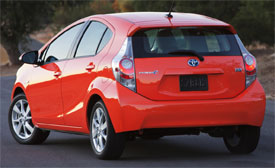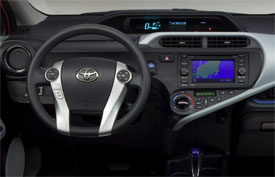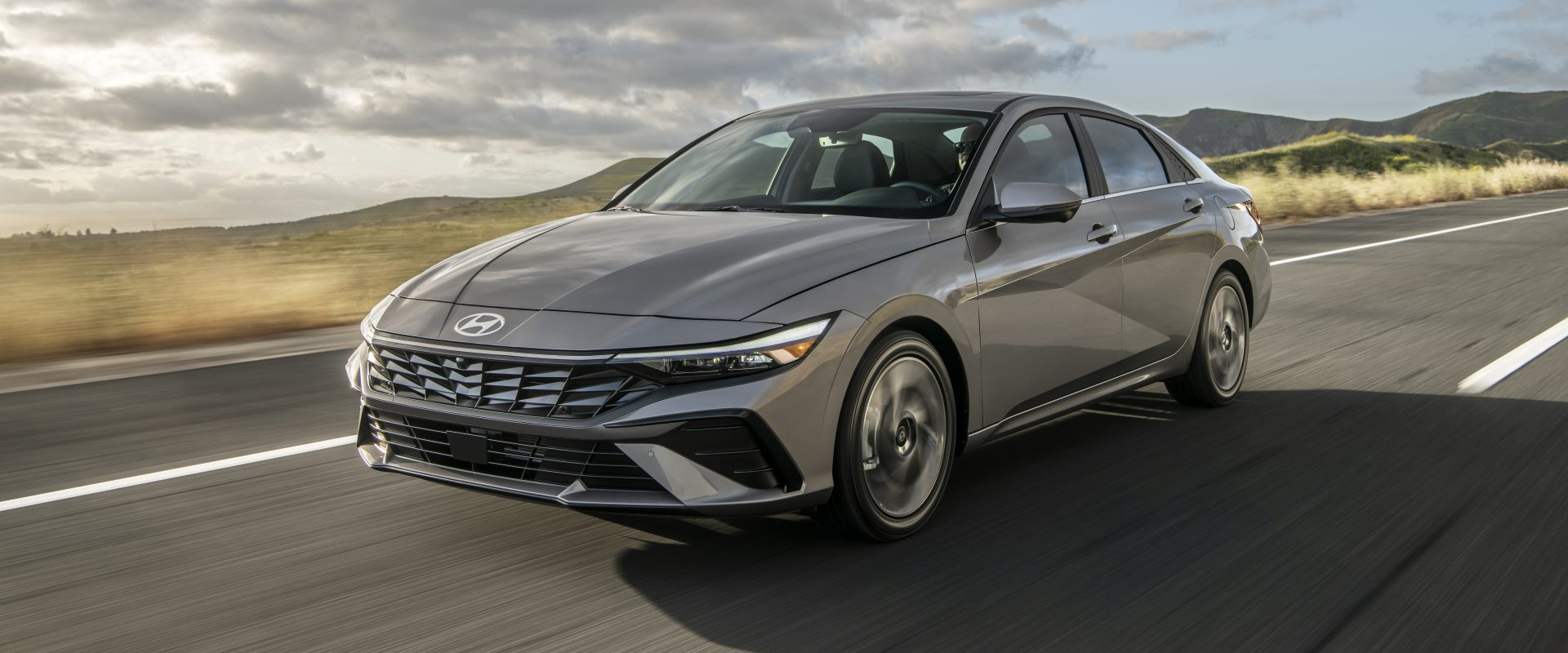2012 Toyota Prius c
By now you’ve heard much about the Toyota Prius family of hybrid cars. Well, the latest member to join the family is its smallest one yet, the Prius C. The C-for-city promises the best around town fuel economy of any non-plug-in hybrid on the road. But, is there anything more to the C, than just good mpg?
Every family is happy to see a new “little-one” arrive, and this 2012 Toyota Prius C is no exception. With great fuel economy being one reason that more people are looking at smaller cars and certainly the main reason people buy hybrids, the C looks to be the perfect marriage of the two and the right car at the right time.
But before we declare that, let’s download the data. The Prius C is based on a shortened Yaris chassis, so when we say it’s a small car, we’re not exaggerating. Wheelbase is just 100.4-inches. Overhangs, both front and rear are very brief, making it appear even shorter than it is. Overall length is just 157.3-inches.
Standard wheels are steel and 15-inches in diameter, with 16-inch alloys optional. Up front, the look is familiar Prius, but with sizable trapezoidal grille openings that help to give it a sportier tilt.
 The rear-end tapers in a bit to optimize aerodynamics, which are also helped by a hatch-top rear spoiler. Tall, vertical tail lights wrap up into the fenders to help give the look some substance. Good thing since the C only weighs 2,500 pounds, or about 500 less than the standard Prius.
The rear-end tapers in a bit to optimize aerodynamics, which are also helped by a hatch-top rear spoiler. Tall, vertical tail lights wrap up into the fenders to help give the look some substance. Good thing since the C only weighs 2,500 pounds, or about 500 less than the standard Prius.
So, not surprisingly it is powered by a downsized Hybrid Synergy Drive system, starting with a 1.5-liter I4 rated at 73-horsepower and 82 pound feet of torque. That little engine-that-almost-can gets much needed help from a pair of electric motor-generators to give a combined output of 99-horsepower.
All of that gets you a Government Fuel Economy Rating of 53 City on Regular gas. While that’s the best of any current hybrid, its highway rating of 46 is actually less than the larger Prius, so the C’s combined rating of 50 is the same.
Energy Impact Scores also match the regular Prius at a stingy 6.6-barrels of oil per year, while emitting only 2.9 annual tons of CO2.
Despite the miniature powertrain, the C’s light weight makes it feel more spirited than its larger brethren. Still, we estimate the 0-to-60 time is similar at about 10.5 seconds.
You can tool around in ECO and EV modes only; there’s no Power mode like the larger cars, and power still flows through a foggy CVT transmission, so there’s nothing sporty to note here either.
For a car that’s designed to be a “city car”, the C holds its own on highways just as well. We never felt a lack of power, but we did have fairly low expectations going in. Visibility is good all around, and the C doesn’t feel tiny when you’re behind the wheel; it’s also quieter than the typical subcompact.
The tilt/telescoping steering wheel has redundant controls, and as in all other current Prius’, Smart Key with keyless entry and push button start is standard.
 The two-tone interior is a good mix of youthful styling with comfort and user-friendliness. Seats are cloth except for top- level C4 trim that get SofTex simulated leather. The folding rear seat is either 1 or 2 piece, depending on which grade you purchase and trunk capacity is generous at 17.1 cubic-feet.
The two-tone interior is a good mix of youthful styling with comfort and user-friendliness. Seats are cloth except for top- level C4 trim that get SofTex simulated leather. The folding rear seat is either 1 or 2 piece, depending on which grade you purchase and trunk capacity is generous at 17.1 cubic-feet.
In current Prius vein, the dash-top gauge cluster includes a color info screen with a multitude of different fuel economy screens, and on the passenger side of the dash is a media tray with USB and auxiliary inputs.
With four trim levels, pricing begins at $19,710 for a Prius C One. That’s some 3 grand less than the standard Prius. The top level C Four is stickered at $23,990.
There’s no argument that the best selling point of the 2012 Prius C is its great fuel economy. But beyond that, the C is also a pretty decent subcompact overall. Add in a well equipped price that doesn’t break the bank, and it looks like the C is indeed more than just good MPG.
Specifications
- Engine: 1.5-liter I4
- Horsepower: 73
- Torque: 82 lb-ft.
- 0-60 mph: 10.5 seconds
- EPA: 53 mpg city/ 46 mpg highway
- Energy Impact: 6.6 barrels of oil/yr
- CO2 Emissions: 2.9 tons/yr
2024 Hyundai Elantra
Basic Transportation At Its Best…And That Is A Compliment
For those of you who write in every week bemoaning the fact that all we seem to do around here is test incredibly expensive cars and EVs that only the very well to do can afford, this one’s for you. It’s a commuter and budget friendly mainstay from Hyundai, the compact Elantra sedan. And, it has been nicely updated for 2024.
We clearly do enjoy driving high-performance machines and ultra-luxury rides around here, but like most of you, when it comes time to drive home at the end of a long workday, we do so in something much more practical and affordable, like this 2024 Hyundai Elantra sedan.
If you’re thinking the front end has gotten more aggressive, you’re right. Hyundai calls it a “Shark Nose” theme, and we’re guessing they were thinking more Great White than Hammerhead, though Megamouth shark would also apply. It helps for a low and wide look; more substantial than the typical compact. Other additions for ’24 include slimmer daytime running lights, revised stainless steel Hyundai emblem, reshaped front fenders, sport sedan-style rear diffuser with silver trim; a parametric pattern added to the C-Pillar, and new LED taillights that take up a lot more space on the highly sculpted decklid. Plus, new wheel designs in sizes ranging from 15- to 18-inches.
Standard engine in SE, SEL, and Limited grades is this naturally aspirated 2.0-liter I4 with 147 horsepower and 132 lb-ft of torque. Even with no hybrid assistance, it gets substantial Government Fuel Economy Ratings of 31 City, 40 Highway, and 34 Combined; we averaged a great 38.6 mpg of Regular.
Those high fuel economy numbers mean acceleration times are pretty high as well. It was in no particular hurry to get off the line at our test track, as after a slight jolt of power, it felt pretty sluggish going down the track, taking us a lengthy 9.4 seconds to hit 60 mph. Hyundai’s Intelligent Variable Transmission has some realistic simulated gear shifts built in, and they not only provided the feel of a true automatic, but kept engine noise from becoming overbearing. And while this 2.0-liter may not be a house-on-fire off the line, it has no problem keeping up with traffic, and feels like just the perfect amount of power for a practical and safe commuter car.
There are other engine options too. Two choices if you want to go faster, a 1.6-liter turbo with 201 horsepower in the Elantra N Line, and a 276-horsepower turbocharged 2.0-liter for the Elantra N; plus, one with even better fuel economy, a 1.6-liter hybrid with a 139 horsepower total output.
And despite some significant understeer, there was good feel through the cones of our handling course, both in steering and chassis feedback. We wouldn’t quite call it “point and shoot,” but it responded to inputs fairly quickly, with only moderate body roll. All-in-all, when it comes to performance, it doesn’t claim to bring a whole lot to the table, but does clearly overachieve with what it does bring.
And Hyundai is always overachieving when it comes to packing in features, yet has found a way of keeping things refreshingly simple with a good mix of touchscreen and manual controls. Lots of space too, both up front in the surprisingly wide front buckets, and in the rear bench with ample room for three. Updates for all Elantra interiors include softer materials on the door panels, upgraded instrumentation and additional charging ports, plus a surround view monitor and new H-Tex simulated leather for Limited trim.
Elantra pricing starts with an SE at $22,775, the SEL comes in at $24,725, Limited begins at $28,215, and the sporty N Line starts at $29,615. If you’re interested in the hybrid, base Blue starts at $27,400 with Limited at $30,600.
Some might say there’s not a whole lot that’s earth shaking about the 2024 Hyundai Elantra, but that’s mostly why we like it so much. When it comes to just delivering good, basic transportation with a high dose of unexpected amenities, Hyundai delivers once again.
Specifications
- Engine: 2.0-liter I4
- Horsepower: 147
- 0-60 mph: 9.4 seconds
- 60-0 Braking: 111 ft (avg)
- MW Fuel Economy: 38.6 MPG (Regular)
- Transmission: IVT
- Torque: 132 lb-ft
- 1/4 Mile: N/A (Track Maintenance)
- EPA: 31 City / 40 Highway / 34 Combined







